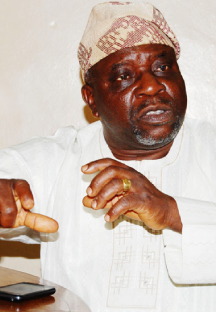
We’ll Not Rest Until Every Osun School Is Transformed – Oyeduntan
Otunba Lai Oyeduntan is the Chairman of the two years old Osun Schools’ Infrastructure Development Committee.

In this interview with DAILY INDEPENDENT he spoke at length on the levels of school upgrades and how the needs assessment and implementation had transformed the school landscape in all corners of the state.
What is the mandate of your committee?
Osun State Infrastructure Development Committee is a committee responsible for the development and upgrade of school infrastructure in the state of Osun. The committee came after the need has been identified of certain policy options to reform school and education sector in the state. It is so because by the time Governor Rauf Aregbesola assumed office, the situation on ground was unacceptable and long before the governor assumed office, he has been associated with the sector. He has had personal experiences that were not particularly encouraging.
Can you give details of the scenario before the intervention?
The percentage of qualified students graduating from Osun secondary schools is so low that in public schools it averages between six and five per cent. That is certainly unacceptable. Performances in both external and internal exams are the only yardstick for measuring efficiency in the school system. For a state like Osun as one of the states where education is very expensive is unacceptable. It will be the irresponsible of the government to ignore it especially having reviewed the sector through the education summit the steps taken in previous years by successive governments to ameliorate the situation.
It was obvious to us after the summit that the intervention in the sector will have to be drastic and comprehensive. There are three factors that are germane to an effective education sector. The pupils must be the main reason for schooling. The pupils therefore must be motivated to want to learn, the teacher that will teach must also be sufficiently encouraged to teach and deliver effectively. All of these must come together in an environment that is conducive for the good mix of teaching and learning.
By 2010, none of those ingredients were in place any more. The pupils are not particularly keen on learning as truancy was the order of the day. The teachers were not well motivated to carry out their assignments. The environment in which all of these were supposed to be taking place was certainly poor and all these are not acceptable at all. Having identified all these imperatives the government set out to tackle them.
Firstly, attempts were made to motivate the students’ through the O’Meal and the phenomena of that alone can be seen in the jump in enrolment in elementary school.
The situation analysis at the beginning of the exercise informed the approach being taken in the re-classification of schools. While looking at what will be the ideal, we discovered several schools with less than 100 pupils with three or four teachers and headmaster or mistress who does not teach. There was no consistency in the whole arrangement between either rural or urban centres. In the urban centres where you have the population, you have schools I, II III which is not in conformity with both teaching and administrative functions. All we have done therefore was to research into best practice all over the world and come with the need to have schools that are of optimum sizes and have maximum facilities that will make teaching and learning more interesting.
In the old primary school, primary I to III are fed. When the food vendors bring the food to the schools the pupils in primary IV, V and VI will not be able to concentrate anymore because their brothers in lower classes are eating and they are going hungry. We discovered that the trend all over the world is to apply science and psychology to the management of the needs of the pupils. The psychological requirements of dealing with a six year old are different with dealing with a 10 year old pupil.
Through this we come to the conclusion that it is better to group the children according to their age group. So six years old to nine year old in grades 1 to 4 are now put in elementary school. Primary 5 and 6 are grouped together with junior secondary school age and high school pupils who are in their late teens are now separated from those in the junior secondary schools. There is nothing extra ordinary about this. Many children in private schools are enrolled in secondary by the time they are nine or ten from primary five. It is just like moving the students who will be in a particular address to the other address where they ordinarily would go in another year. This led to the re-classification of schools and focusing of what the needs are at that level in terms of amenities and facilities appropriate for a given age group.
Having identified the needs driven re-classification exercise, what was the estimation of the infrastructural needs of the system and to what extent has your committee delivered on this?
We recognized the need for a total departure from the routine that is in practice within the system because it was obvious it had failed. The previous government perhaps recognized the need for this same intervention but the enormous amount of money required usually frightens successive governments in the state. We have however come to the conclusion that we cannot run away in tackling the challenges. The governor has demonstrated sufficient political will to address the issues. Even if we have all the monies in this world to address and build all those schools at the same time, the journey of 1000 miles has thus begun with one step by bringing the schools up to what is the trend in modern world.
Education as important as it is should not be treated with levity. We went through a comprehensive data collection and application and came to a conclusion that there is a difference between school in urban centre and in rural areas. Some schools in rural areas may have to remain there even though the population is low but in urban centres, it calls for the optimum size. Elementary school must remain neighourhood schools. That is, the average elementary school pupils should not do more than two kilometers from home in order to get to school. But again it is not difficult for us to achieve. We have not created new schools; we have not moved a school from its location to another. We have only moved the pupils around within the same number of schools, same number of classrooms and for the same purpose.
When you move primary five and six into another school, vacancy is created into which to move primary 1 to four from other schools and vii-a-vis move primaries 1 to four again and that has been the matter of re-allocation of the pupils within the same number of schools there are already in existence. It is not as if the schools were closed down or construction of new schools somewhere else. All the schools we are building are on existing schools.
On estimation until the last school is built and transformed into a functional esthetically purpose built school our job is not done.
When we started we recognized the enormity of task in terms of funding. Having demonstrated the political will we have received substantial supports from outside of the normal government purse. The national assembly caucuses have put their entire constituency projects together and the fund is being diverted to fund education. Through that 12 schools will be affected this year and another 12 next year. All our MDG projects are now focused on education. This is simply because the governor has demonstrated that passion for the restructuring and intervention in forms of reforms that is taking place. They have bought into the project and any donor agency that is coming into the state is encouraged to support us along this thinking more than anywhere else.
In terms of physical appropriation, how much has your committee expended on this mission to rebuild. I am aware of the Baptist school commissioned recently.
That is the first and would not be the last. What I meant by first is that all others are coming about the same time. We started less than two years ago having the desk work of designing approval and securing funding for the project. The first of the elementary school was delivered at Salvation Army School, Alekuwodo, Osogbo. It used to be middle school and you have that type of upgrade when you talk of middle schools. When you talk of numbers we started as funding is available for our contractors to move to site. Therefore the completion date will be staggered. In the next few weeks we should be able to accommodate at least 10,000 elementary school pupils in brand new schools. In the next few weeks we should be able to accommodate middle school pupil about 14,000 in new schools.
For this year our attention is now shifting to comprehensive renovations instead of building new schools. Comprehensive renovations suggest that roof ceilings, floor, windows and doors will be replaced to the standard of a brand new school. Some structures will have to be removed to bring back sanity that used to pervade such schools where the standard distribution of structures conforms to layout plans unlike what we have in the past, where blocks of three classrooms are constructed on playgrounds without regard to the esthetics of the schools. This is in recognition of the fact that education for us is not about learning to read and write alone but the need to have a complete man come out of the system.
And that complete man must see himself as a major stakeholder in our society. He must appreciate the esthetic decency of the environment that is well beyond the basic functionalities. That is why all our facilities are designed with decency and functionality in mind. The high school is a much bigger school with capacity for 3.000 in the same premises with governance imperative that goes with that number of population. It is meant to encourage the finishing school for the basic education. By the time an average Osun student leaves our high school he or she should not be intimated by any campus or college anywhere because we would have introduced such population and governance that goes with such size of school and functionality esthetics of the environment.
One, when we talk about numbers, you will observed that I didn’t talk about 10 or that number, I went straight to identify the beneficiaries of what we are doing because you track every kobo being spent by the state of Osun to the eventual beneficiaries.
All the sites we have executed we insisted that local vendors and artisans must be patronized first unless such expertise cannot be sourced locally then we look elsewhere. We have deployed about three technologies in the construction models of the schools. We have used light steel model fabrication system where three elementary have been and three high schools will also be built using the system. We have deployed the conventional sand Crete system that is common and we have also used the composite bricks as used by the MDG. All of these were brought in to enhance the accessibility of the state to different methods in construction.
Talking about crowding in school, what are the arrangements put in place to address this problem that is common place in public schools?
We are aware of the so called ratio of 25 to a teacher standard. But if you are coming from a background of having about 80 in a classroom then getting 50 in a classroom would be a record. The target is to achieve 25 and rebuild every classroom in Osun but the reality is that yes we have a school year with 25 full classrooms with each classroom measuring 50 square metres that is the capacity for 50. Before now the same size of classroom is where pupils are crowded. Crowding is not uniform. In rural communities you can have less than 20 in a class. But In urban centres the pressure is on accommodation and that is where our intervention comes in. It is the analysis of the number of pupils to a classroom ratio that informed the need to have a well spaced out purposely designed schools. What used to happen is that because of the pressure of enrolment population, a block of three classrooms are built at any available space thus leading to destruction of playground and even construction of classrooms close to highways.
We have a purpose designed the average capacity of a school is 1,000 from what we have before and we still have some of them with 300, 500 and 60 pupils in primary one to six. That is the kind of range and disparity that we have seen that informed the need to have a controlled approach to the distribution and location of the schools.
What is the distribution of the schools?
We do have an even spread and politically it is even smart to concentrate. You must have political spread because there are constituencies. Every constituency will demand for its share any way. But let us be pragmatic because those schools are there to address a problem and to serve the people. Rural areas may not be able to accommodate the standard size of schools we are building. If am building five schools and I want to accommodate 5,000 pupils, I will go to where the population is thick. Like you have rightly observed that overcrowding usually occurs in urban centres so if this others states if you go back to how they did their own planning they must be trying to reach a large number of pupils within the limited resources available to them.
We have here our own statistical background to the planning for the distribution of the schools, the distribution of enrolment, the clusters of population density and where the needs are more pressing. I have a rural school with only 60 pupils from primary one to six all I need to do is to clean it up for them because it does not attract the kind of resources and allocation a school in town with about 1,000 students of 50 in each class. This is pragmatism. But politically speaking even by law you must have spread. When you talk of distribution we are reaching all sections of the state. Presently we are building 14 for elementary and 15 for middle schools.
Talking about meeting the infrastructural deficit in Osun schools, what is the benchmark for construction to ensure that quality work is done?
We spoke of classification for elementary school pupils from age 6 to 9, middle school pupils from ages 9 to 15 and high school pupils from 15 to 18. We got architects and our brief was quite clear. We have structures that are designed to suit the needs of the respective age groups. Our schools are designed with functionality and esthetics in mind. Functionality is the size of the classrooms, and the spatial arrangement of the buildings that comes with security. Talking about access, control nobody gets into the new schools without being screened and once you are inside you cannot regress from the premises without being attended to and screened. So the average child that comes into school is bound to stay unless authorized to go out. The schools are fenced with controlled entry and exit points. The designs were purpose driven and directed.
The middle school is a story building in U shape and fenced. You cannot drive into the learning arena because there is a parking lot. All visitors and staff of the school access and exists the school through the same points. The elementary schools are neighborhood schools; the middle is a bit further not more than what they used to do in going to grammar schools. The high school on the other hand is for adults at the age 15 or 16 who able to do a few things by themselves. The high school addresses heavy population centres. In the whole of Ilesa there will be two and in Osogbo there will be three at Olorunda and Ejigbo to absorb the identified high population of high school students. But the issue is by the time am done with this sets of high schools; we will be able to accommodate close to 40,000 students translating to about one third of the high school population. If the cost of the facilities, the concentration, amenities that will be provided and the governance in place we can them to perform better, we would have increased the fortune of this number of young adults. Rather than trying to please 100 people and getting nowhere why don’t I concentrate on 30 and deliver and end up with 25 per cent performance. Whereas using the mega resources o face 100 was getting 5 per cent. We realize that we must concentrate our efforts on building these building blocks for the future of our society and education.
In totality what are the gains of infrastructural rebirth in Osun schools?
The governor came prepared to focus on education because of the importance of the sector that underpins every aspiration of man and society. A situation where our people start off life with a disadvantage is certainly unacceptable and no responsible government should ignore whatever it takes to effect a change.
The totality of the reform in the education is that the infrastructural enhancement is just but one of the intervention mechanisms. Teachers have been motivated, more teachers have been recruited; arrears of leave bonuses and entitlements have been paid. Teaching in the state has been professionalized. Teachers in the state can now rise to the rank of permanent secretary. The issue is not all about tangibles.
The intangibles are even more important than the tangibles. The tangible is the mind and what determines the man himself. His self esteem, his own estimation of self worth, if he sees himself as a significant member of the community of the society he lives in he will strive to make the community better. He would strive to be a good citizen. We have had a lot of rots out that must not continue. So if we have been able to arrest the rot, we can now think and clam for the growth period. Right now, we are at the point of arresting the rot while waiting for the growth to come naturally because the ground has already been prepared. The objective is to bring Osun back to that competitive edge it has as a supplier of critical manpower, quality of human capital within the committee of states and nations. A people that have grown to realize that they potentials and attain that within an enabled environment though we ranked so low in terms of revenue but rank high in the distribution of wealth.
Are the schools with hostel accommodation and safety?
The high school will come with hostel facilities to be run by private developers and individual but superintendent and controlled in terms of quality and standard by the state. People will be encouraged to build hostels for the schools based on set standards so that students coming to high school can stay within the hostel. We have seen the need for hostel because many parents did not know what their children do after 2 in the afternoon when schools have closed until the parents return in the evening. Hostel environment helps to manage and mould these young adults.
The kind of social re-engineering we are doing will reduce extremism to a minimum because hopelessness breeds the kind of extremism that is threatening the unity of the country and our lives. All of these have been taken into account. The size of the courtyard has something to do with safety. In case of emergency there must be sufficient space as muster point.
The size of the school will obviously make it impossible for the school head to manage in terms of emergencies, what we have done is to engage a school manager for each of the school. His responsibility is to ensure the safety of the students’ and facilities. Ensure the school is neatly kept ensure the functionality of facilities available in the school. This responsibility leaves the teachers to concentrate with academics. By the time the schools are in place it our responsibility to let people have the drills in order to be able to recognize danger and at least knock off the alarm in times of emergency. There will be fire drills because what is important under such situation is the reaction time for people to recognize the need to escape to safety in an orderly manner.
DAILY INDEPENDENT



